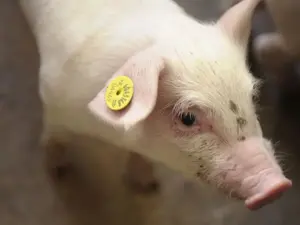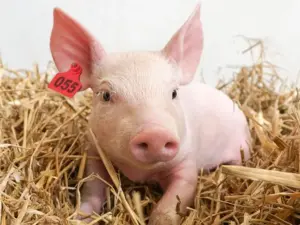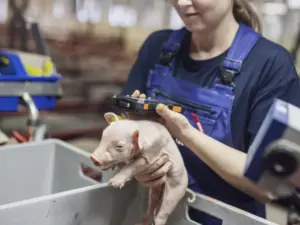Introduction:
Do you know the importance of pig ear tags? Ear tagging in pigs is usually done for identification processes. They provide convenience during pig breeding, slaughtering, and sales. You can identify a large number of pigs using ear tags. Before moving on to the main context of this topic, let’s first understand the definition of pig ear tags.
What are Pig Ear Tags?

Pig ear tags are electronic label classifications for pigs in the breeding industry. These pig tags are easy to use and disassemble. They consist of two parts: the first one is a main tag, and the second one is an auxiliary tag.
Why Do Pigs Need Ear Tagging?
Do pigs need ear tags? The answer is simple. Yes, the pigs need ear tags. They are the most essential part of the whole management system. Ear tags for pigs are the best way of recording and collecting pig breeding information. It’s adapted on a large scale in various countries. These ear tags help in complete tracking and monitoring of the entire process. It includes everything from birth and slaughter to sales, consumers, and final consumption.
Now, let’s answer this question with some simple reasons- do pigs need ear tags?
Why are Pig Ear Tags Important?

1. Convenient for Safe Production
Pig ear tags are a valuable tool for the clear identification of livestock. They also help in the detailed management of livestock. With the help of ear tags, the breeding industry can identify hidden dangers well before the time. So, they can take proactive control measures that ensure convenience for safe production.
2. Improve the Detailed Management of the Farm
The identification of individual pigs is important in livestock and poultry farm management. So, easy-to-manage ear tags help in the identification of animals like pigs. Each pig gets a different pig tag with a unique code. These pig ear tags contain information like the pig house and farm numbers. It also stores the pig’s number. You can manage things with handheld computers once you tag pig ears. These might include things like death, meditation, and weighing. It also contains things like managing immunization diseases, material, and diseases. Moreover, it keeps track of daily information like slaughter records and breeding.
3. Manage Husbandry and Disease Control
Pig ear tags collect and manage essential details about each pig, such as source and variety. It also contains details like ear number, production performance, immune status, and owner. They also help track pigs during the times of epidemics or quality issues. Thus, it identifies their source, plugs loopholes, and assigns responsibility. This means it understands the science behind animal husbandry. Ear tags for pigs take husbandry management to the next level.
4. Supervise the Safety of Livestock Products
The pig carries the electronic ear tag for life. The electronic code can help trace back to the pig’s selling site and the slaughterhouse. Ear tags for pigs also help trace production sites and supermarkets with pork for sale. The records are available at the end if brought by a cooked food processing vendor. Such a marking function helps tackle a mainstream of participants. Please note that these are the participants who sell dead and sick porks. It helps supervise the safety of domestic livestock products. Thus, this makes sure that the people eat only healthy pork.
Preparation Tips to Keep in Mind Before Ear Tagging in Pigs

- Ensure tagging pigs and staff goes smoother with as little stress as possible.
- Get a solid handling system in place to tag fast and without fuss.
- Brighten up the space and make sure the floor isn’t slippery. Pick tags that fit the pig’s size and type right.
- Grab the right pliers and double-check they’re clean and ready to roll.
- Keep some antiseptic wipes or disinfectant on hand if you need to clean the pliers or the pig’s ears.
- Tag a sow or gilt, and pop a tag in each ear. So that if one goes missing, you’ve still got the other one to tell you who she is. (Note: Sows and gilts are breeding herds).
How Can You Avoid Pigs Entering the Herd?
Before bringing new piglets into the herd, ensure you have the right tags and pliers to attach them. It would help if you held the piglet in a safe way for both of you. Sometimes, their ears might need a quick clean to avoid infection. Let’s face it: cleanliness matters. Once that’s sorted, pop the tag right in the middle of the ear. Also, steer clear of any veins or bumpy cartilage to avoid discomfort. Putting it too close to the edge could mean it gets torn out – ouch! After you’re done, give those pliers a good clean. Finally, tuck them away with any leftover tags, keeping everything tidy for next time.
How Do you Re-tag If Tags are Absent?
Pig ear tags often become lost, necessitating a straightforward re-tagging process. Then, the process happens straight through the original hole. It minimizes discomfort for the pig. Units perform this task at weaning during the regrouping of pigs. If this is one of the common issues you face with missing tags, it’s crucial to reevaluate. Yes, it’s time to reevaluate our tagging approach or the design and material of the ear tags you’re using.
Always Remember!
Tagging occurs when pigs join the breeding population. This also applies to replacing tags for sows or gilts when needed. In closed herds, workers might tag new litters. It is preferable to do this shortly after birth for clear identification. They do it using unique colors or numbers for tags.
A unique identification number is important for each pig in the breeding group. Workers must replace missing tags on sows with their original ID tags. If a sow’s identity is unknown, they should assign her a new number. Some farms use slap markings on gilts for permanent identification. It’s only done in case their ear tag falls off. When you enter the breeding herd, pigs often receive sequential numbers. These sequential numbers have variations in prefixes or tag colors. It indicates intake batches, parity levels, or different breeding strategies within the herd.
